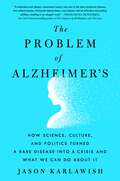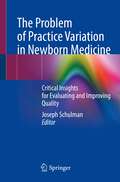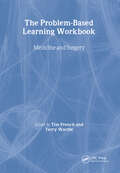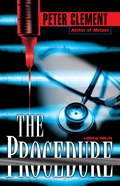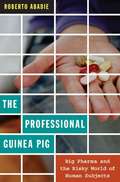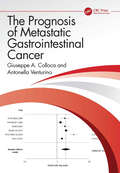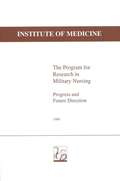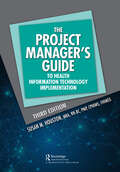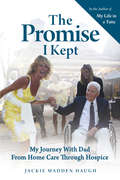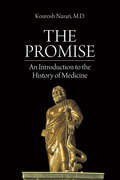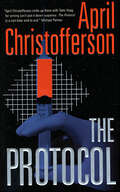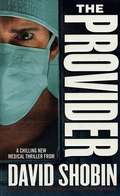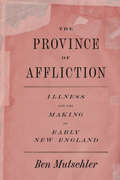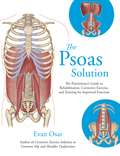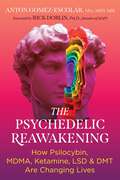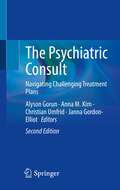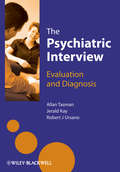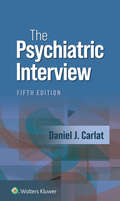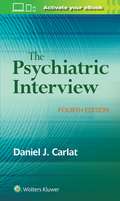- Table View
- List View
The Problem of Alzheimer's: How Science, Culture, and Politics Turned a Rare Disease into a Crisis and What We Can Do About It
by Jason KarlawishA definitive and compelling book on one of today's most prevalent illnesses.In 2020, an estimated 5.8 million Americans had Alzheimer’s, and more than half a million died because of the disease and its devastating complications. 16 million caregivers are responsible for paying as much as half of the $226 billion annual costs of their care. As more people live beyond their seventies and eighties, the number of patients will rise to an estimated 13.8 million by 2025. Part case studies, part meditation on the past, present and future of the disease, The Problem of Alzheimer's traces Alzheimer’s from its beginnings to its recognition as a crisis. While it is an unambiguous account of decades of missed opportunities and our health care systems’ failures to take action, it tells the story of the biomedical breakthroughs that may allow Alzheimer’s to finally be prevented and treated by medicine and also presents an argument for how we can live with dementia: the ways patients can reclaim their autonomy and redefine their sense of self, how families can support their loved ones, and the innovative reforms we can make as a society that would give caregivers and patients better quality of life. Rich in science, history, and characters, The Problem of Alzheimer's takes us inside laboratories, patients' homes, caregivers’ support groups, progressive care communities, and Jason Karlawish's own practice at the Penn Memory Center.
The Problem of Practice Variation in Newborn Medicine: Critical Insights for Evaluating and Improving Quality
by Joseph SchulmanNeonatal intensive care unit (NICU) teams in the US and around the world receive performance reports that locate their particular value for selected process and outcome measures within the range of values from all reporting NICUs. Understandably, many providers focus primarily, if not exclusively, on their particular value. When a value appears undesirable, providers often justify it in an apparent reflex response rather than critically analysing their data. Exceedingly few reflect on the width or implications of the range within which their performance lies. Standard medical education does not include these skills, yet unwarranted practice variation necessarily compromises a population’s overall quality of care. Researchers report wide variation in health care resource use with little connection to patient outcomes, challenging the belief that directing incrementally more resources at certain healthcare problems necessarily produces better results. This book provides requisite knowledge to enable readers without research expertise to understand the notion of unwarranted practice variation, how to recognize it, its ubiquity, and why it is generally undesirable – why narrowing is pervasiveness improves quality. The book begins by describing practice variation, its prevalence, and why it matters. Next, it examines alternative conceptualizations of NICU work. One view is task-oriented, while the other is aim-oriented. NICU teams rarely articulate their aims explicitly, so this book offers examples that guide thinking and action. Finally, this book asks, “Which rate is 'right'; what is the performance target?” The answer entails identifying the lowest resource use rate associated with desirable outcomes. This requires data describing efficient and predictably performing provision of current evidence-based care, along with relationships to a variety of outcomes. Provider conceptualization of healthcare quality also is often vague. The challenge lies in defining this notion operationally. This book does precisely that and gives readers tools to think critically about process, outcome, and quality measures, via some understanding of systems, risk-adjustment modelling, and discriminating signal from noise in process data.
The Problem-Based Learning Workbook: Medicine and Surgery
by Terry Wardle Tim FrenchGeneral practitioners need to know more and more about the complicated tests performed in hospitals. For most patients the GP is an accessible trusted and reliable source of information and advice. So when patients under hospital follow-up are confused about their treatment they often turn to their GP. In addition general practitioners have open access to an increasing array of hospital-based investigations and in the context of clinical governance they have a greater responsibility to understand and use them properly. This guide provides a compendium of all those hospital-based tests which the GP is likely to encounter organised according to specialty. It also includes the rather more specialised tests available only to the relevant consultant but which GPs might end up having to explain to perplexed patients. Each chapter is written by a specialist in the field and the book is edited by a general practitioner to be presented in a uniform digestible way. This essential resource enables GPs to order secondary care investigations confidently and rationally and to answer patients' queries with authority.
The Procedure (Dr. Earl Garnet #3)
by Peter Clement"Heartpounding suspense," hailed Entertainment Weekly of Peter Clement's first medical thriller, Lethal Practice. Now the former ER physician has done it again--combining his technical expertise with a page-burning plot to create a chillingly plausible novel of suspense. With authentic detail and a surgeon's precision, Clement captures the tense, electrifying atmosphere of a big city hospital turned into a flash point. For in Fatal Medicine, one threat is more dangerous than contagion: the threat of human beings deciding who should live and who should die. . . . Death is a daily, sometimes hourly, occurrence at St. Vincent's Hospital in Buffalo, New York. Now, in his pressure cooker career, Dr. Earl Garnet has broken the cardinal rule of modern medicine: he publicly blames a powerful HMO for practicing "no-fault murder" in the death of an eighteen-month-old baby. The HMO swiftly strikes back, igniting a debilitating boycott of the hospital. But after several accidents nearly cost patients their lives, the true bloodletting begins. A doctor is found sprawled out in the parking lot, his throat cut ear to ear. Blamed for instigating the chaos, Earl Garnet knows that he faces more than a deadly power play. The doctor may have uncovered a conspiracy reaching from the halls of one of the nation's most influential HMOs to a small, experimental clinic in Mexico, where yet another of his patients went for treatment and disappeared. To find answers, Garnet must wade deep into the murky, surreal workings of today's health care industry. Smart, tough, crackling with suspense, and vivid in its hospital setting, this visionary novel instantly places Peter Clement in the distinguished company of Michael Palmer and Robin Cook. Make no mistake: The Procedure is the work of a first-rate physician and an absolutely brilliant storyteller.
The Profession and Practice of Horticultural Therapy
by Rebecca L. Haller Christine L. Capra Karen L. KennedyThe Profession and Practice of Horticultural Therapy is a comprehensive guide to the theories that horticultural therapists use as a foundation for their practice and provides wide-ranging illustrative models of programming. This book aims to enhance understanding and provide insight into the profession for both new and experienced practitioners. It is directed to students in the field, along with health care and human service professionals, to successfully develop and manage horticultural therapy programming. The book is organized into four sections: an overview of the horticultural therapy profession, theories supporting horticultural therapy use, models for programs, and tools for the therapist. Areas of focus include: Overview of the profession, including the knowledge, skills, and abilities needed to practice Discussion of related people-plant endeavors and theories supporting horticultural therapy Issues within the profession of horticultural therapy, including employment models, professionalism and ethics, and credentials Characteristics and implementation of therapeutic, vocational, and wellness program models Accommodations and adaptive techniques to best serve the needs of all participants Strategies for assessment and documentation for horticultural therapy intervention Issues for managing programs including how horticultural therapy programs collaborate with other disciplines, determining program costs and budget, managing staff and growing spaces, and conducting program evaluations Horticultural therapy serves the needs of the whole individual when practitioners have a broad and deep comprehension of the theories, techniques, and strategies for effective program development and management. The Profession and Practice of Horticultural Therapy provides relevant and current information on the field with the intent to inspire best practices and creative, effective programs.
The Profession of Orientation and Mobility in the 1980s: The AFB Competency Study
by Mark M. Uslan Everett W. Hill Alec F. PeckThis book is a report of two national studies to compile descriptive statistical information about the demographic trends that will influence the future of the O&M profession--one conducted in 1983 and the other in 1985.
The Professional Guinea Pig: Big Pharma and the Risky World of Human Subjects
by Roberto AbadieThe Professional Guinea Pig documents the emergence of the professional research subject in Phase I clinical trials testing the safety of drugs in development. Until the mid-1970s Phase I trials were conducted on prisoners. After that practice was outlawed, the pharmaceutical industry needed a replacement population and began to aggressively recruit healthy, paid subjects, some of whom came to depend on the income, earning their living by continuously taking part in these trials. Drawing on ethnographic research among self-identified "professional guinea pigs" in Philadelphia, Roberto Abadie examines their experiences and views on the conduct of the trials and the risks they assume by participating. Some of the research subjects he met had taken part in more than eighty Phase I trials. While the professional guinea pigs tended to believe that most clinical trials pose only a moderate health risk, Abadie contends that the hazards presented by continuous participation, such as exposure to potentially dangerous drug interactions, are discounted or ignored by research subjects in need of money. The risks to professional guinea pigs are also disregarded by the pharmaceutical industry, which has become dependent on the routine participation of experienced research subjects. Arguing that financial incentives compromise the ethical imperative for informed consent to be freely given by clinical-trials subjects, Abadie confirms the need to reform policies regulating the participation of paid subjects in Phase I clinical trials.
The Prognosis of Metastatic Gastrointestinal Cancer
by Giuseppe A. Colloca Antonella VenturinoSurvival of patients with metastatic cancer has increased over the past two decades as a result of a progressive improvement of regional and systemic therapies. However, oncologists' estimates of patients' predicted overall survival in metastatic cancer are imprecise. The purpose of this book is to systematize the evidence regarding the prognostic factors of metastatic gastrointestinal tumors, separating the findings with the highest level of evidence among those available for each disease by selecting studies with the highest scientific evidence level.
The Program for Research in Military Nursing: Progress and Future Direction
by Committee on Military Nursing ResearchHigh-quality nursing care is essential to obtaining favorable patient outcomes, no less so in military than in civilian settings. Military nursing research focuses on enhancing health care delivery systems and processes to improve clinical outcomes, to advance the practice of military nursing in support of mission readiness and deployment, and to improve the health status and quality of life of military personnel and their beneficiaries.This volume reviews the military nursing research program of the TriService Nursing Research Program in terms of its management, funding, allocation of resources, and identification of program goals. The book also contains the results of that study and the committee's recommendations.
The Project Manager's Guide to Health Information Technology Implementation: The Project Manager's Guide To Health Information Technology Implementation (HIMSS Book Series)
by Susan M. HoustonThis book focuses on providing information on project management specific for software implementations within the healthcare industry. It can be used as a guide for beginners as well as a reference for current project managers who might be new to software implementations. Utilizing the Project Management Institute’s (PMI) methodology, the defined process groups and knowledge areas will be defined related to implementing custom and commercial off-the-shelf (COTS) software. The Software Development Life Cycle (SDLC) is a standard for developing custom software but can also be followed for implementing COTS applications as well. How will the system be set-up from an architecture and hardware standpoint? What environments will be needed and why? How are changes managed throughout the project and after? These questions and more will be reviewed. The differences between types of testing are defined as well as when each are utilized. Planning for the activation and measuring the success of the project and how well the strategic need has been met are key activities that are often not given the time and effort to plan as the other parts of the implementation project. This new edition updates the current content to better align with the newest version of the PMI’s Project Management Body of Knowledge (PMBOK), the latest technology and concepts. In addition, this new edition includes additional chapters on agile management, stakeholder management, and choosing the right methodology.
The Promise of Welfare Reform: Political Rhetoric and the Reality of Poverty in the Twenty-First Century
by Elizabeth SegalFind out how-and why-legislation has made economic rights more important than human rightsSince 1996, politicians and public officials in the United States have celebrated the "success" of welfare reform legislation despite little, if any, evidence to support their claims. The Promise of Welfare Reform: Political
The Promise: An Introduction to the History of Medicine
by Kourosh NazariFor centuries, one principle has stood above all others in the medical field: First, do no harm. But has our basic healthcare lost this vital philosophy in its pursuit of advancement and profit? Follow the journey of medicine from its earliest beginnings at the dawn of humanity to the incredible technological advances of the 21st century. By examining key figures and events, this book’s focus on the rationales of pioneering practitioners and the philosophies behind major discoveries sets it apart from current medical and historical literature for both providers and consumers of healthcare.In the age of unprecedented advancements, the evolution of medicine and its underlying philosophies has been cast aside for the pursuit of the next, best development. In the search to provide the best care, human history has had great triumphs but also great horrors. It is important in our healthcare pursuits, both as patient and practitioner, to remember that history and examine how today’s medicine fits within its historical progression.
The Prostate Cancer Dilemma
by Nelson N. Stone E. David CrawfordThis text provides a comprehensive, state-of-the art review of this field, and will serve as a valuable resource for clinicians, surgeons and researchers with an interest in early prostate cancer. The book reviews new data about genetic markers, transperineal mapping biopsy and mpMRI, how to apply each of these technologies in patients with elevated PSA, when a prior prostate biopsy performed by the standard TRUS method is negative and in cases where low risk disease is already diagnosed, how to differentiate those men who might harbor more aggressive disease from those who do not. Over 75% of newly diagnosed prostate cancer meets the criteria for low risk disease which has created a dilemma for both patients and clinicians. Active surveillance programs have been initiated and are reviewed. How the new technologies impact surveillance programs is addressed. Clinical stage designation is updated and a new intra-prostatic staging system is discussed. Prostate biopsy techniques utilizing transrectal ultrasound, transperineal mapping, elastography and mpMRI are compared. Finally, utilization of this new technology in the application of focal therapy is reviewed. The Prostate Cancer Dilemma will serve as a very useful resource for physicians and researchers dealing with, and interested in this challenging malignancy. Chapters are written by experts in their fields and include the most up to date scientific and clinical information as well as links to procedural video content.
The Protocol
by April ChristoffersonJennifer has to prove that Dr. Fielding funded his biotech firm by dealing in illegally obtained human organs - including her husband's -- for transplant into the bodies of people who could pay almost any price to extend their lives. But that's not the worst of Sherwood Fielding's trangressions against nature, as Jennifer soon finds out.Working on the cutting edge of a lucrative field like genetics is risky - and Jennifer finds herself in a maelstrom of murder, industrial espionage, deceit and personal betrayal. Embroiled in a plot of unimaginable medical perversion, Jennifer must fight for the truth about the science being done at the firm. Especially as it leads her to the truth of how and why her husband died.At the Publisher's request, this title is being sold without Digital Rights Management Software (DRM) applied.
The Provider
by David ShobinUniversity Hospital is a gleaming showplace of modern medicine. But a string of tragic deaths has struck the neonatal unit-- each young fatality marked by a bizarre pathology. No one understands what could be causing the senseless deaths-- and no one is trying to find out.But one young doctor is determined to uncover the truth. As Dr. Brad Hawkins follows the twisted corridors and the shrouded secrets of University Hospital, he begins to uncover an unthinkable conspiracy of evil and greed. And as the tiniest victims continue to perish, Brad is racing against time, to catch a murderer who operates with startling brutality-- and save himself from ending up in the hospital morgue...
The Province of Affliction: Illness and the Making of Early New England (American Beginnings, 1500-1900)
by Ben MutschlerIn The Province of Affliction, Ben Mutschler explores the surprising roles that illness played in shaping the foundations of New England society and government from the late seventeenth century through the early nineteenth century. Considered healthier than people in many other regions of early America, and yet still riddled with disease, New Englanders grappled steadily with what could be expected of the sick and what allowances were made to them and their providers. Mutschler integrates the history of disease into the narrative of early American social and political development, illuminating the fragility of autonomy, individualism, and advancement . Each sickness in early New England created its own web of interdependent social relations that could both enable survival and set off a long bureaucratic struggle to determine responsibility for the misfortune. From families and households to townships, colonies, and states, illness both defined and strained the institutions of the day, bringing people together in the face of calamity, yet also driving them apart when the cost of persevering grew overwhelming. In the process, domestic turmoil circulated through the social and political world to permeate the very bedrock of early American civic life.
The Province of Affliction: Illness and the Making of Early New England (American Beginnings, 1500-1900)
by Ben MutschlerIn The Province of Affliction, Ben Mutschler explores the surprising roles that illness played in shaping the foundations of New England society and government from the late seventeenth century through the early nineteenth century. Considered healthier than people in many other regions of early America, and yet still riddled with disease, New Englanders grappled steadily with what could be expected of the sick and what allowances were made to them and their providers. Mutschler integrates the history of disease into the narrative of early American social and political development, illuminating the fragility of autonomy, individualism, and advancement . Each sickness in early New England created its own web of interdependent social relations that could both enable survival and set off a long bureaucratic struggle to determine responsibility for the misfortune. From families and households to townships, colonies, and states, illness both defined and strained the institutions of the day, bringing people together in the face of calamity, yet also driving them apart when the cost of persevering grew overwhelming. In the process, domestic turmoil circulated through the social and political world to permeate the very bedrock of early American civic life.
The Psoas Solution: The Practitioner's Guide to Rehabilitation, Corrective Exercise, and Training for Improved Function
by Evan OsarThe first book to comprehensively discuss the function of the psoas in posture, movement, and exercise, The Psoas Solution identifies the functional anatomy, biomechanics, and motor control of the psoas and its role in core and hip stabilization. Integrating research with clinical experience, Evan Osar identifies the psoas's role on the hip, pelvis, and low back and demonstrates how to incorporate the psoas into functional movement patterns including squatting, lunging, and bending. The Psoas Solution includes corrective and functional exercise progressions for improving and integrating the psoas into daily activities. Health and fitness professionals will find this a valuable resource full of applicable strategies and exercises to incorporate into current rehabilitation or training programs. Abundantly illustrated with full-color images throughout, this book also provides most complete review on the relevant research on the psoas available.For years the psoas has been a muscle mired in controversy. It has been linked to common postural and movement dysfunction including anterior pelvic tilt, hyperlordosis of the lumbar spine, and low back pain. Strategies to improve posture and reduce pain have primarily involved stretching the psoas and strengthening its antagonist, the glutes. However, recent clinical research has revealed that the psoas is much more than a simple hip flexor and plays an integral role in both posture and movement. This professional treatment manual for health care practitioners and students gives an overview of the ways that non-optimal use of the psoas can affect breathing, posture, and movement. It outlines specific treatment strategies that enable patients to develop awareness and utilization of the psoas muscle to achieve three-dimensional breathing and improve balance and body mechanics.
The Psychedelic Reawakening: How Psilocybin, MDMA, Ketamine, LSD, and DMT Are Changing Lives
by Anton Gomez-Escolar• Examines the contemporary psychedelic phenomenon, including the history of criminalization and legalization, psychedelics&’ effects on the brain, recent clinical research, and new therapeutic potentials• Explores substances like psilocybin, LSD, DMT, ayahuasca, ketamine, and MDMA, including scientific evidence for psychedelics&’ potential to treat addiction, depression, anxiety, trauma, and neurodegenerative diseases• Includes extensive practical information on safety, risk, and harm reduction for both laypeople and mental health practitionersPresenting a comprehensive guide to the exciting new landscape around psychedelics, psychopharmacologist Anton Gomez-Escolar examines the long history of criminalizing and (slowly) legalizing these substances and their increasingly demonstrable positive effects on body, mind, and spirit.Exploring psilocybin, LSD, DMT, ayahuasca, ketamine, MDMA, and other substances, Gomez-Escolar looks at the multitude of scientific studies providing critical evidence for psychedelics&’ ability to treat addiction, depression, anxiety, and trauma as well as their potential to treat neurodegenerative diseases such as Alzheimer&’s. He provides key information for therapists and other health practitioners as well as explores the potential benefits and limitations of microdosing and how psychedelics could help with various neurological and mental health issues, including those related to the COVID-19 pandemic. Breaking down substances by type, the author looks at the main risks of each psychedelic and its benefits, best harm-reduction strategies, and the neural pathways each affects. Gomez-Escolar also includes a large selection of resources for people seeking to engage personally with psychedelics for healing.
The Psychiatric Consult: Navigating Challenging Treatment Plans
by Janna Gordon-Elliott Alyson Gorun Anna M. Kim Christian UmfridThis book guides psychiatry trainees through some of the most common psychiatric consultation requests in the general medical hospital, using accessible, case-based narratives. Clinical case scenarios are used to demonstrate how to consider both medical and psychological factors involved in the consultation, and the approach to challenging interpersonal dynamics that may occur between the hospitalized patient and the primary medical team. Each case illustrates how to begin to think like a consultation-liaison psychiatrist in order to arrive at a diagnosis and formulate a treatment plan in complex clinical situations. Cases unfold in real time to highlight the critical role of the psychiatrist as liaison to the patient and medical team in order to guide psychiatric management and facilitate effective communication and treatment in the hospital. In addition to clinical cases, each chapter features a concise list of strategies to identify and address patient symptoms and behaviors, interpersonal dynamics, and barriers to care that arise in the hospital. The Psychiatric Consult features resident-specific recommendations and a case-based format that make it a unique, realistic, and engaging learning tool.
The Psychiatric Consult: Navigating Challenging Treatment Plans
by Alyson Gorun Anna M. Kim Christian Umfrid Janna Gordon-ElliotThis book guides psychiatry trainees through some of the most common psychiatric consultation requests in the general medical hospital, using accessible, case-based narratives. Clinical case scenarios are used to demonstrate how to consider both medical and psychological factors involved in the consultation, and the approach to challenging interpersonal dynamics that may occur between the hospitalized patient and the primary medical team. Each case illustrates how to begin to think like a consultation-liaison psychiatrist in order to arrive at a diagnosis and formulate a treatment plan in complex clinical situations. Cases unfold in real time to highlight the critical role of the psychiatrist as liaison to the patient and medical team in order to guide psychiatric management and facilitate effective communication and treatment in the hospital. In addition to clinical cases, each chapter features a concise list of strategies to identify and address patient symptoms and behaviors, interpersonal dynamics, and barriers to care that arise in the hospital. The Psychiatric Consult features resident-specific recommendations and a case-based format that make it a unique, realistic, and engaging learning tool.
The Psychiatric Interview
by Allan Tasman Robert Ursano Jerald KayWhile the ABPN has now supplied such standards for psychiatry, psychiatric interviewing instruction has not been standardized in the US or in other countries. Similarly, the few psychiatric interviewing books available are written in textbook form, often long and often from the subpecialty perspective (e.g. psychodynamic interviewing). Critically, no interviewing guides to date take a true biopsychosocial perspective. That is, they limit themselves to "interviewing" as an isolated technique divorced from full patient assessment, which for quality patient care must include the interface of psychological and social components with biological components. Similarly, few interviewing texts are fully integrated with DSM/ICD categorical diagnostic schemata, even though these descriptive diagnostic systems represent the very core of our clinical language--the lingua franca of the mental health professions. Without good descriptive diagnoses there cannot be adequate communication of clinical data among providers.The proposed book will meet this need for training in biopsychosocial assessment and diagnosis. The patient interview is at the heart of psychiatric practice. Listening and interviewing skills are the primary tools the psychiatrist uses to obtain the information needed to make an accurate diagnosis and then to plan appropriate treatment. The American Board of Psychiatry and Neurology and the Accrediting Council on Graduate Medical Education identify interviewing skills as a core competency for psychiatric residents. The Psychiatric Interview: evaluation and diagnosis is a new and modern approach to this topic that fulfills the need for training in biopsychosocial assessment and diagnosis. It makes use of both classical and new knowledge of psychiatric diagnosis, assessment, treatment planning and doctor-patient collaboration. Written by world leaders in education, the book is based on the acclaimed Psychiatry Third Edition by Tasman, Kay et al, with new chapters to address assessment in special populations and formulation. The psychiatric interview is conceptualized as integrating the patient's experience with psychological, biological, and environmental components of the illness.This is an excellent new text for psychiatry residents at all stages of their training. It is also useful for medical students interested in psychiatry and for practicing psychiatrists who may wish to refresh their interviewing skills.
The Psychiatric Interview
by Daniel J. CarlatFocusing on the practical skills needed to establish rapport with patients and gain valuable clinical insights,The Psychiatric Interview, 5th Edition, offers a practical, concise approach to improving interviewing skills. Noted psychiatrist and award-winning mental health journalist Dr. Daniel J. Carlat uses a proven combination of mnemonics, specific techniques for approaching threatening topics, and phrasing examples to illustrate the nuances of the interviewing process, making this easy-to-digest text essential reading for trainees and practitioners in psychiatry, psychology, nursing, social work, and related fields.
The Psychiatric Interview (Fourth Edition)
by Daniel J. CarlatNow DSM-5 updated! Using a unique and effective combination of mnemonics, practical techniques, and phrasing examples that illustrate the nuances of the interviewing process, The Psychiatric Interview, 4th Edition helps you establish a rapport with patients and gain valuable clinical insights. Now updated to incorporate the DSM-5 and current research, this popular manual teaches you how to improve your interviewing skills, breaking down this complex area into concise information you can put to use immediately in your practice.
